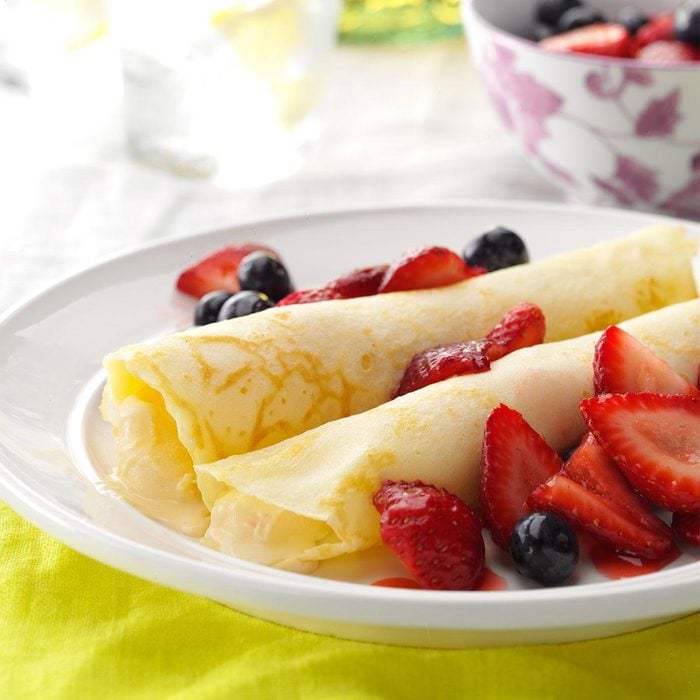This traditional Danish pancake recipe makes a thin, eggy pancake (similar to a crepe, but even thinner, with crispy edges) that is rolled, plumped with ice cream and topped with fresh berries. Also known as pandekager, Danish pancakes cook in a small, nonstick skillet, where the batter is quickly poured, cooked and flipped to brown each side.
This is a decadent brunch or dessert treat that would pair nicely with a butternut and bacon strata. And as you make the recipe more often (we’re confident that you’ll want to), you can experiment with toppings and fillings—peaches and thick vanilla yogurt, or a dusting of confectioner’s sugar are two to try.
Ingredients for Danish Pancakes
- Eggs: With a slightly higher ratio of eggs than called for in traditional American pancakes, this recipe yields a thinner, custardy pancake.
- Milk: Whole milk will make the batter the right consistency when you make this recipe for Danish pancakes.
- Butter: As always, melted butter brings richness to this recipe.
- Flour: All-purpose flour helps to create the structure of these pancakes.
- Sugar: Granulated sugar sweetens the batter, and a bit more is sprinkled on top after cooking for texture.
- Vanilla ice cream: Vanilla ice cream is what separates this pancake from the rest. A few tablespoons are dropped into each pancake before it’s rolled up.
- Fresh berries: Fresh blueberries and sliced strawberries are sprinkled on top of these sweet pancakes just before serving.
Directions
Step 1: Start the batter
In a large bowl, whisk together the eggs, milk and butter.
Step 2: Add the dry ingredients
In a separate small bowl, whisk the flour and 2 tablespoons of sugar. Add the dry ingredients to the egg mixture, and mix well. Cover and refrigerate for about an hour.
Danish Pancake Variations
- Swap the filling: If you prefer breakfast vibes over dessert, trade the ice cream for vanilla Greek yogurt and top the pancake with plums, peaches or nectarines.
- Go full sundae: You’re already stuffing the pancakes with ice cream, so why stop there? Make a Danish pancake sundae by drizzling it with chocolate syrup, then topping it with whipped cream and cherries.
- Add some protein: Stuff the pancakes with a tablespoon of your favorite nut butter and top them off with sliced bananas and cinnamon.
How to Store Danish Pancakes
Store leftover pancakes in an airtight container, separated with parchment paper, in the refrigerator for two to three days.
Can you make this Danish pancake recipe ahead of time?
Yes, in two different ways. The batter can be made the day before and stored in the refrigerator overnight. The cooked pancakes can also be stored in the fridge, as noted above, or frozen for two months. Add the ice cream, roll it up and add toppings when you’re ready to serve.
Danish Pancake Tips
What’s the other famous Danish pancake?
Aebleskivers are small, round, puffed pancakes made in a special pan with indentations that make it easy to cook and flip the little cakes.
What type of pan is best for thin pancakes?
Whether you’re making Danish pancakes, Swedish pancakes or crepes, the pan is important. An 8-inch pan works best. It can be nonstick, like an omelet pan, or a seasoned carbon steel pan. No matter which pan you use, greasing it is important, and more butter or oil should be added after you cook a few pancakes.
Can I use a blender to mix the batter?
Yes, for this type of eggy pancake, overmixing isn’t an issue. If you have a blender, it can whip up the batter quickly and efficiently. However, this makes the rest time even more important, as it helps diffuse any air bubbles that may have been created while mixing.



















